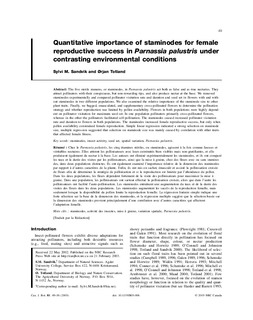Quantitative importance of staminodes for female reproductive success in Parnassia palustris under contrasting environmental conditions.
Journal article, Peer reviewed
Permanent lenke
http://hdl.handle.net/11250/138221Utgivelsesdato
2003Metadata
Vis full innførselSamlinger
Originalversjon
Sandvik, S. M., & Totland, O. (2003). Quantitative importance of staminodes for female reproductive success in Parnassia palustris under contrasting environmental conditions. Canadian Journal of Botany, 81(1), 49. http://dx.doi.org/10.1139/B03-006Sammendrag
The five sterile stamens, or staminodes, in Parnassia palustris act both as false and as true nectaries. They attract pollinators with their conspicuous, but non-rewarding tips, and also produce nectar at the base. We removed staminodes experimentally and compared pollinator visitation rate and duration and seed set in flowers with and without staminodes in two different populations. We also examined the relative importance of the staminode size to other plant traits. Finally, we bagged, emasculated, and supplementary cross-pollinated flowers to determine the pollination strategy and whether reproduction was limited by pollen availability. Flowers in both populations were highly dependent on pollinator visitation for maximum seed set. In one population pollinators primarily cross-pollinated flowers, whereas in the other the pollinators facilitated self-pollination. The staminodes caused increased pollinator visitation rate and duration to flowers in both populations. The staminodes increased female reproductive success, but only when pollen availability constrained female reproduction. Simple linear regression indicated a strong selection on staminode size, multiple regression suggested that selection on staminode size was mainly caused by correlation with other traits that affected female fitness. [ABSTRACT FROM AUTHOR]
Beskrivelse
Copyright NRC Press
